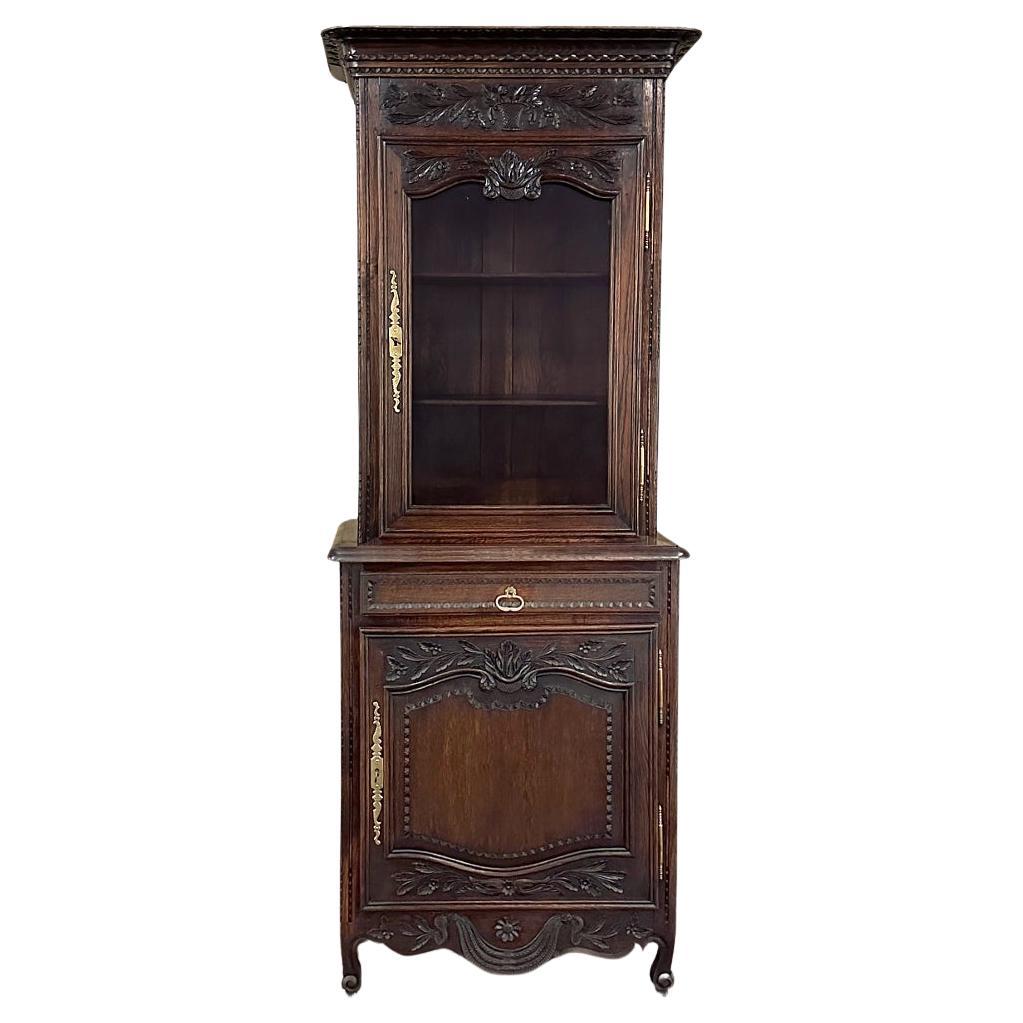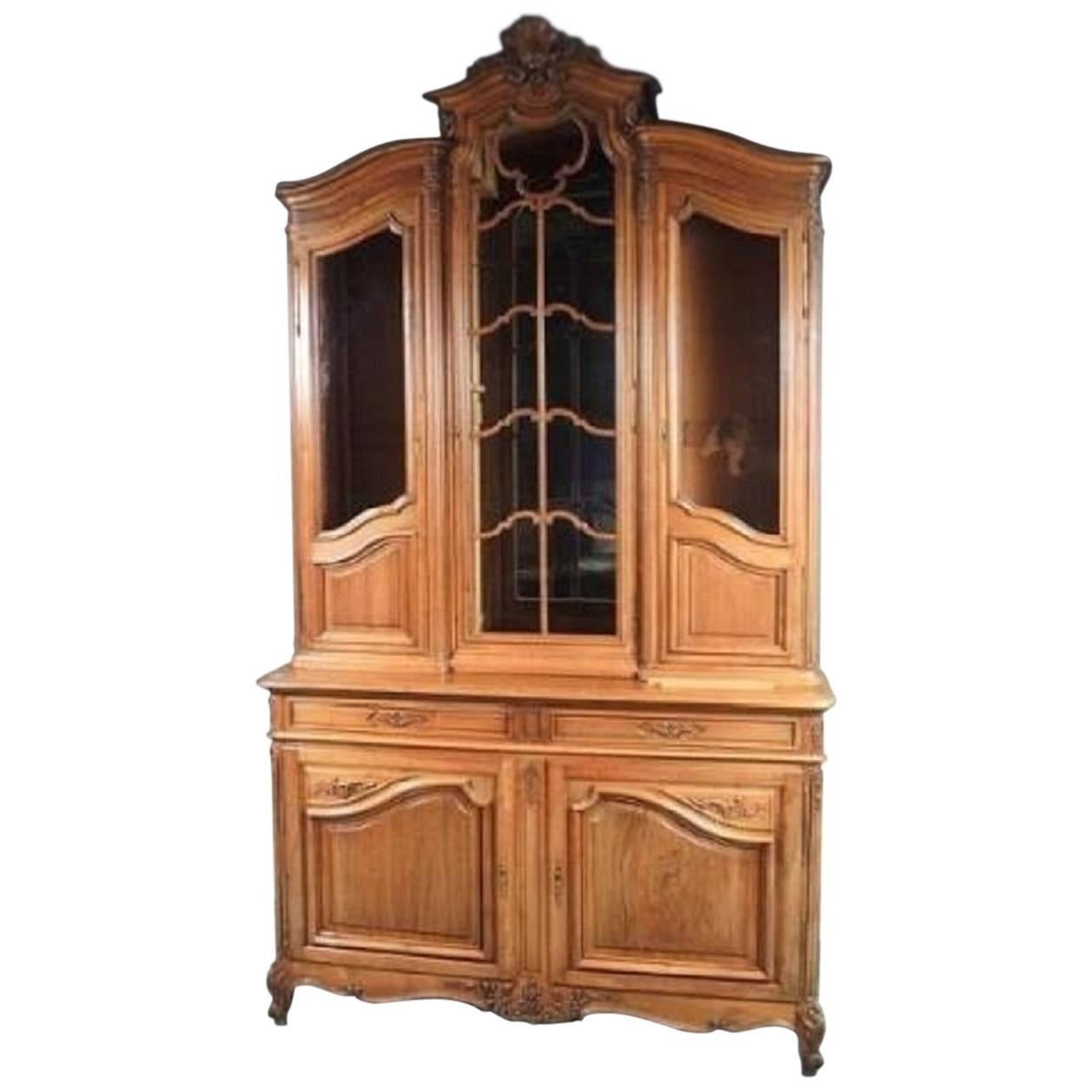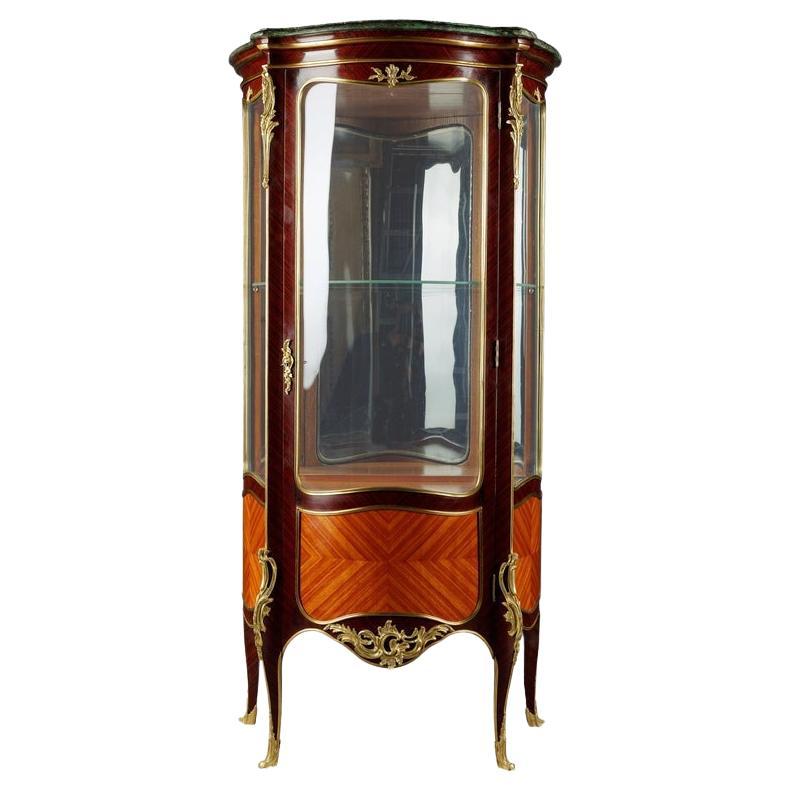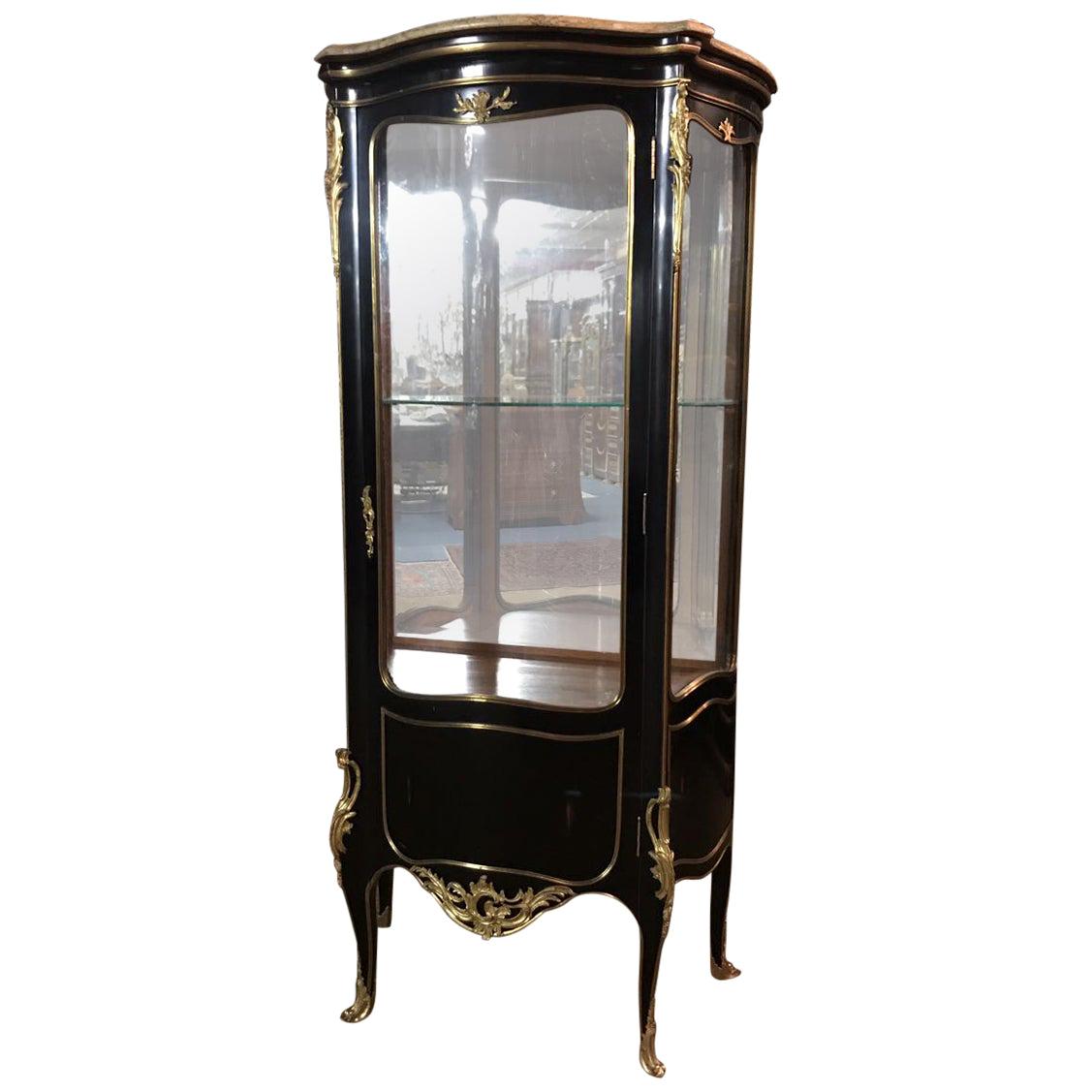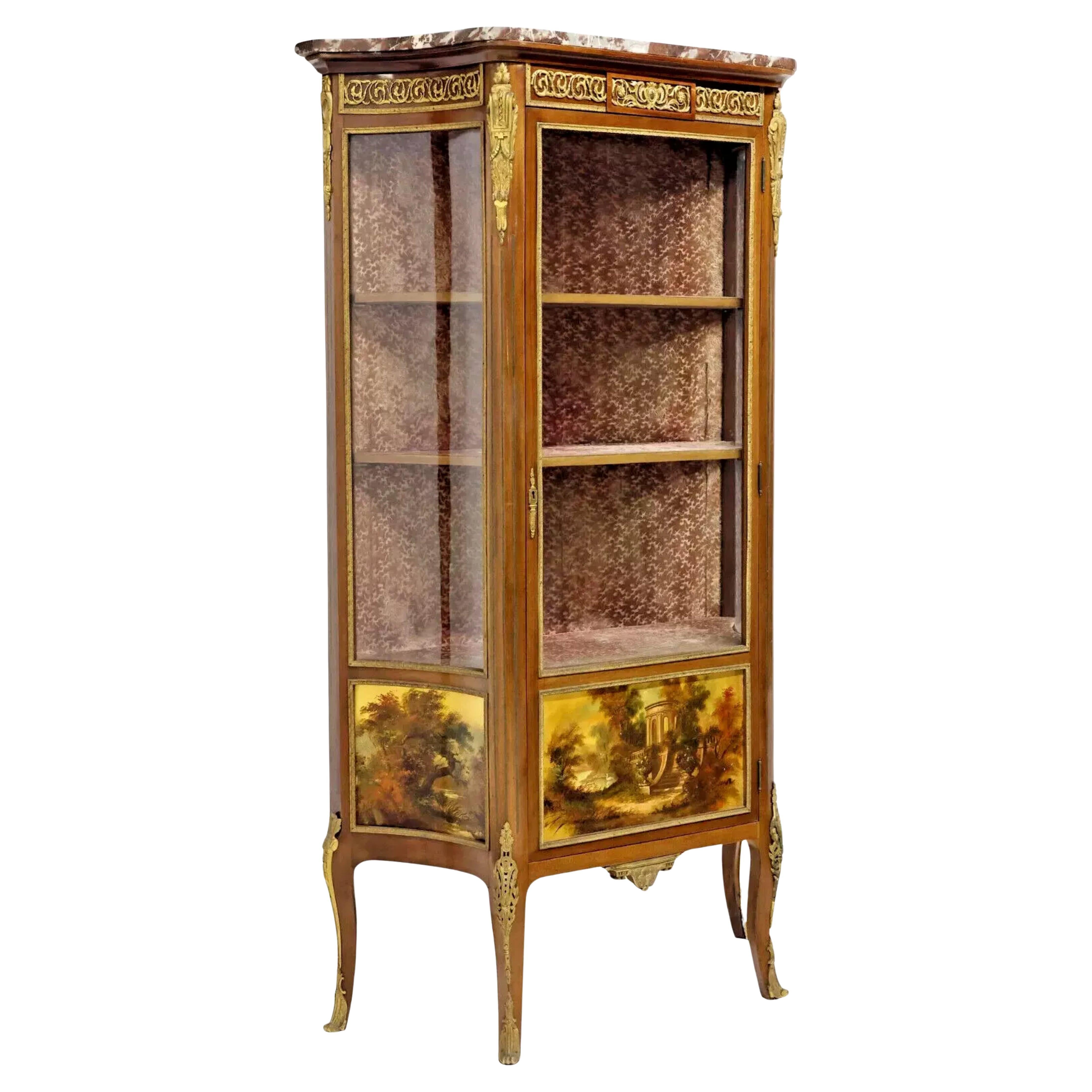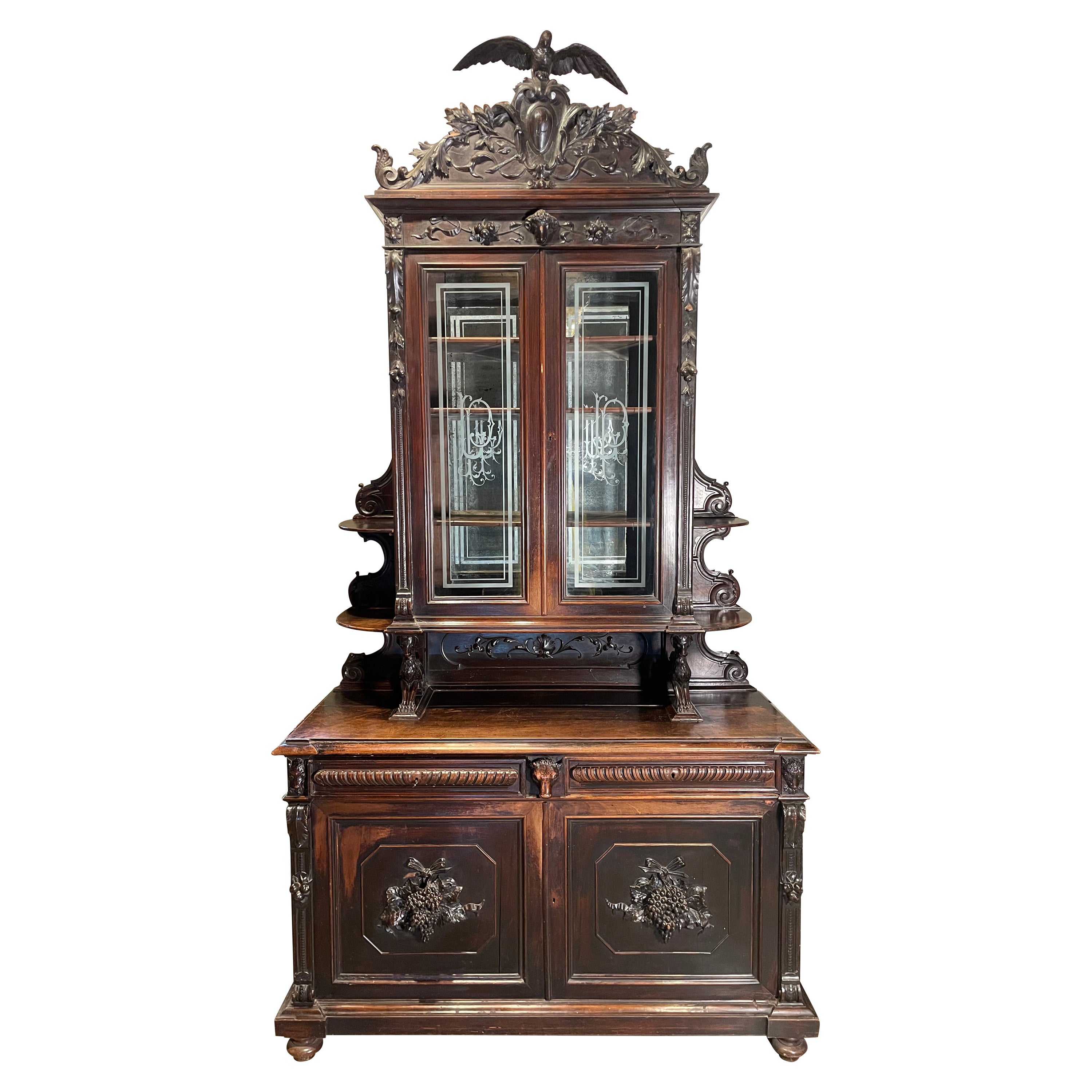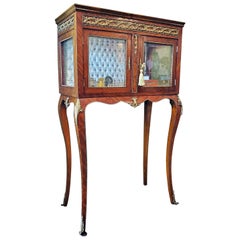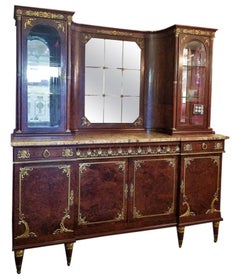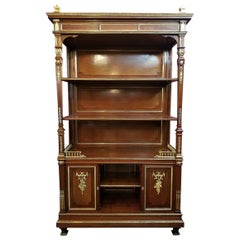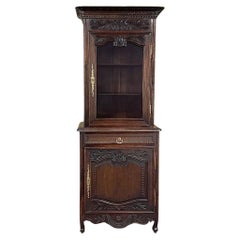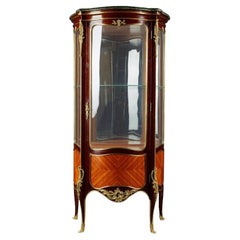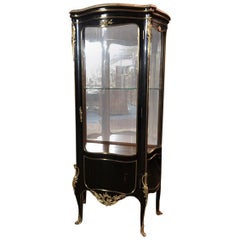Items Similar to Large 19 Century French Rococo or Neoclassical Revival Style Vitrine
Want more images or videos?
Request additional images or videos from the seller
1 of 21
Large 19 Century French Rococo or Neoclassical Revival Style Vitrine
$9,600
$18,60048% Off
£7,221.22
£13,991.1148% Off
€8,323.66
€16,127.0948% Off
CA$13,522.66
CA$26,200.1648% Off
A$14,837.58
A$28,747.8248% Off
CHF 7,765.30
CHF 15,045.2748% Off
MX$182,600.38
MX$353,788.2448% Off
NOK 97,831.14
NOK 189,547.8348% Off
SEK 91,633.44
SEK 177,539.7948% Off
DKK 62,151.86
DKK 120,419.2348% Off
About the Item
Stunning 19th century French Empire, neoclassical/Rococo Revival style Marquetry vitrine or display cabinet, of large proportions!!
A real statement piece!
Made of a fabulous variety of veneers, including kingwood, satinwood, tulipwood, harewood and walnut with quality classical ormolu mounts.
It has ebonized pillars in the Empire style, with walnut and exotic hardwood friezes in the Rococo style.
Double glass doors to middle section and single glass doors on either side.
The glass on the doors are framed in ormolu banding.
Floral Marquetry panels on front and parquetry on the sides.
The front central section is a pullout / pull-out drawers with gorgeous walnut frieze panel and original carved walnut knobs.
Scrolling pelmet on the top in 3 sections banded in ormolu beading.
Scrolling base with cabriolet feet and ormolu mounts on base.
Various ormolu mounts, floral mounts, mounts of Baachus and mounts of neoclassical female figures.
In 3 sections. with 2 side cabinets and large central section with 3 section pelmet, stunning piece!!!
The quality ormolu mounts are marked with the letter “R” and what appears to be “FR 678”.
We were originally of the belief that this piece might have been made at the very end of the 19th century, but having regard to the quality of workmanship throughout this piece we are of the opinion that it was most likely made in the third quarter of the 19th century, circa 1870 and by an obviously top quality Parisienne maker with a surname beginning with “R”.
It is definitely in the style of David Roentgen who was known for his Rococo/neoclassical styles.
David Roentgen, (born Aug. 11, 1743-died Feb. 12, 1807, Wiesbaden, Duchy of Nassau), cabinetmaker to Queen Marie-Antoinette of France; under his direction the family workshop at Neuwied (near Cologne), founded by his father, Abraham Roentgen, became perhaps the most-successful firm of furniture production in the 18th century.
After succeeding his father as head of the Neuwied workshop in 1772, Roentgen strove to broaden their clientele, an ambition that brought him first to Hamburg and ultimately to Paris (1774), where in 1779 he was spectacularly successful in selling his finest furniture to King Louis XVI of France for £3,300 to £4,000, an unprecedented sum for the time.
Appointed cabinetmaker to the queen, Roentgen was granted admission (1780) as maître-ébéniste (master cabinetmaker) to the trade corporation of Paris cabinetmakers, making it possible for him to keep in Paris a stock of the furniture manufactured at Neuwied. Thus he was able to compete with such great cabinetmakers as Jean-Henri Riesener and Adam Weisweiler, reputedly his former pupil at Neuwied. After his first visit to St. Petersburg, Empress Catherine II the Great bought huge quantities of his furniture; King Frederick William II of Prussia was also his client. When in 1795 the French Revolutionary armies threatened to cross the Rhine, Roentgen evacuated his establishment and moved his stock farther inland. Unfortunately, he lost everything in his Parisian salon and in his Neuwied workshop, both of which were sacked by Republican troops. He was crushed, despite his appointment as court furnisher to the king of Prussia. Although he never succeeded in starting production again, former apprentices of his whom he helped to establish in the German cities of Berlin (David Hacker) and Brunswick (Christian Härder) were successful.
The Rococo Revival style emerged in Second Empire France and then was adapted in England. Revival of the Rococo style was seen all throughout Europe during the 19th century within a variety of artistic modes and expression including decorative objects of art, paintings, art prints, furniture, and interior design. In much of Europe and particularly in France, the original Rococo was regarded as a national style, and to many, its reemergence recalled national tradition. Rococo Revival epitomized grandeur and luxury in European style and was another expression of 19th century Romanticism and the growing interest and fascination with natural landscape.
During the late half of the 19th century, Rococo Revival was also fashionable in American furniture and interior design. John Henry Belter was considered the most prominent figure of Rococo Revival furniture making. Revival of the Rococo style was not restricted to a specific time period or place, but occurred in several waves throughout the 19th century.
Roentgen had begun his career by continuing and developing the Rococo furniture that his father had introduced. The furniture of his “French” style is characterized by curved outline, sometimes decorated with rich carvings. His “English” cabinetwork is based on elements dating from the early years of King George III and occasionally influenced by the renowned furniture manufacturer Thomas Chippendale. Both national types are frequently decorated with rich inlay of outstanding charm and elegance composed of a variety of woods, some tinted and made to form figural and floral compositions, often in the manner of chinoiserie (Chinese motifs). Between 1775 and 1780 Roentgen abandoned his earlier styles in favor of rigid, classical forms, the effect of which is often based on contrasting mahogany with rich bronze appliqués, represented in his monumental combined secrétaire and medal-cabinet of circa 1785-1789. His workshop indulged in mechanical devices, a characteristic flair begun by his father, that made drawers and mirrors appear and disappear by pressing on hidden releases; Peter Kinzing invented many of these gadgets and provided the workshop with clockworks.
Seriously impressive and imposing piece of furniture!!!
Glass shelving in the interior. These are plate glass shelves with 3 in the central section and 3 each in the side cabinets. Using the floor of the display areas makes 4 shelving areas in each section. It has been wired for internal lighting with a touch button with 3 light settings.
Provenance: Bought at Auction in Ireland.
Made circa 1860-1870.
Dimensions: 88 inches (7.34 feet) high x 76 inches (6.34 feet) wide and 27 inches deep
Condition: Very good original condition. Has been re-gilded and some very minor professional repairs.
- Similar to:David Roentgen (Cabinetmaker)
- Dimensions:Height: 88 in (223.52 cm)Width: 76 in (193.04 cm)Depth: 27 in (68.58 cm)
- Style:Rococo Revival (Of the Period)
- Materials and Techniques:
- Place of Origin:
- Period:
- Date of Manufacture:1860-1870
- Condition:Repaired: Some minor repairs to the ormolu banding on the base. Re-gilted using 18 carat gold leaf. Wired for interior illumination. Wear consistent with age and use. Minor losses. Very good original condition. Has been re-gilted and some very minor professional repairs..
- Seller Location:Dallas, TX
- Reference Number:1stDibs: LU3978120225342
About the Seller
4.9
Gold Seller
Premium sellers maintaining a 4.3+ rating and 24-hour response times
Established in 2015
1stDibs seller since 2018
393 sales on 1stDibs
- ShippingRetrieving quote...Shipping from: Dallas, TX
- Return Policy
Authenticity Guarantee
In the unlikely event there’s an issue with an item’s authenticity, contact us within 1 year for a full refund. DetailsMoney-Back Guarantee
If your item is not as described, is damaged in transit, or does not arrive, contact us within 7 days for a full refund. Details24-Hour Cancellation
You have a 24-hour grace period in which to reconsider your purchase, with no questions asked.Vetted Professional Sellers
Our world-class sellers must adhere to strict standards for service and quality, maintaining the integrity of our listings.Price-Match Guarantee
If you find that a seller listed the same item for a lower price elsewhere, we’ll match it.Trusted Global Delivery
Our best-in-class carrier network provides specialized shipping options worldwide, including custom delivery.More From This Seller
View All19C Louis XV Style Boudoir Display Vitrine
Located in Dallas, TX
PRESENTING a BEAUTIFUL and ELEGANT 19C Louis XV Style Boudoir Display Vitrine .
From circa 1890 and made in France.
This is a tall legged vitrine and has beautiful ormolu mounts an...
Category
Antique Late 19th Century French Louis XV Vitrines
Materials
Ormolu
19th Century Louis XVI Style Cabinet in the Manner of Grohe Freres
Located in Dallas, TX
PRESENTING a GORGEOUS late 19th Century French Louis XVI STyle Cabinet in the Manner of Grohe Freres.
From circa 1880.
ABSOLUTELY FABULOUS Ormolu mounts...
Category
Antique Late 19th Century French Louis XVI Cabinets
Materials
Ormolu
$7,200 Sale Price
60% Off
Exceptional 19C French Empire Style Buffet/Vitrine by AME Fournier
By A.M.E Fournier
Located in Dallas, TX
PRESENTING an OUTSTANDING, IMPORTANT and UNIQUE 19C French Empire Style Buffet/Vitrine by AME Fournier.
Pieces by A.M.E. Fournier are EXTREMELY RARE and ...
Category
Antique Late 19th Century French Empire Revival Credenzas
Materials
Siena Marble, Ormolu
$76,000 Sale Price
39% Off
Rare 19C Portois & Fix Viennese Cabinet
By Portois & Fix
Located in Dallas, TX
PRESENTING A STUNNING and RARE 19C Portois & Fix Viennese Cabinet.
Made by the famous and highly desirable maker, ‘Portois & Fix’ in Vienna, Austria ...
Category
Antique Late 19th Century Austrian Belle Époque Cabinets
Materials
Brass, Ormolu
$20,800 Sale Price
46% Off
Early 19th Century British Mahogany Gothic Revival Wardrobe
Located in Dallas, TX
Beautiful early 19th century, circa 1830, William IV Period, mahogany Regency Gothic Revival wardrobe or armoire or linen press with central mirrored tabernacle and 5-drawer chest of...
Category
Antique Early 19th Century English William IV Wardrobes and Armoires
Materials
Mahogany
$3,600 Sale Price
47% Off
18th Century British Regency Bureau Chiffonier in Manner of Gillows
By Gillows of Lancaster & London
Located in Dallas, TX
Fantastic piece in impeccable condition. Regency exotic hardwood bureau or secretaire desk or cabinet of lovely proportions.
From circa 1790. The top portion consists of an open columned pelmet and shelf with a series of drawers underneath. All made of rosewood. The bottom section is a double door cabinet with double shelving inside. The façade of the doors consist of glorious gilded latticework frames with rose shaped connectors and with brown silk blinds...
Category
Antique Late 18th Century English Regency Cabinets
Materials
Rosewood
You May Also Like
19th Century Country French Two-Tiered Vitrine
Located in Dallas, TX
19th Century Country French Two-Tiered Vitrine is a marvel of the furniture maker's art! Hand-crafted from dense, old-growth oak, hand-rolled glass and hand-forged brass, it harks b...
Category
Antique Early 19th Century French Louis XV Vitrines
Materials
Brass
Late 19th Century Louis XV Style French Hand Carved Vitrine a Deux Corps
Located in Sofia, BG
A late 19th century Louis XV style French vitrine a deux corps made of solid walnut with raised panels and beautiful carved details. Crown has curved corners with floral carving at t...
Category
Antique Late 19th Century French Louis XV Buffets
Materials
Glass, Walnut
$1,997 Sale Price
55% Off
20th Century Louis XV Style French Vitrine
Located in Berlin, DE
Petite French cabinet in the style of Louis XV Rococo.
Bois-Satiné veneer, all-round surface-covering mirror veneer on solid conifers. High-rise, one-armed, cambered body, three-side...
Category
20th Century Vitrines
Materials
Bronze
French Display Case Vitrine in the antique Louis XV Style beech veneer
Located in Berlin, DE
Plywood black polished veneer on solid softwood. High-rise, one-door, cambered and three-sided glazed body on high slanted, angled feet. Profiled cornice with marble top. Inside two ...
Category
Late 20th Century French Louis XV Vitrines
Materials
Beech
E. 1900's Antique French Louis XV Style, 'Vernis Martin' Cabinet, Vitrine!!
Located in Austin, TX
Gorgeous E. 1900's Antique French Louis XV Style, 'Vernis Martin' Cabinet, Vitrine!!
Antique Vitrine, Display Cabinet, French Louis XV Style, 'Vernis Martin', Mahogany, Marble Top...
Category
Early 20th Century Louis XV Vitrines
Materials
Wood, Mahogany
1852 Ornate Italian Vitrine
Located in Los Angeles, CA
This Italian vitrine from 1852 is actually four separate parts, it towers over you at ten feet high, and is absolutely majestic. It features a dove in flight on top of a cameo of foliage and garlands that rest upon the upper cabinet. This upper section is adorned with a large rams head in the center of the upper band. The front has two glazed door with etched glass flanked by Acanthus scrollwork and two corner shelves. Two gorgeous hand carved grotesques in the form of Wolfhounds support the upper case. The base cabinet has two hand-scalloped drawers separated by a large bull-calf’s head...
Category
Antique Mid-19th Century Italian Renaissance Vitrines
Materials
Glass, Wood
More Ways To Browse
Antique Revival Furniture
French Rococo Frame
Large Neoclassical Painting
Rococo Ormolu
18th Century French Rococo Painting
Lighted Vitrine
Antique Ormolu Vitrine
French Neoclassical Prints
Neoclassical Mahogany Mirror
German Wood Carved Figures
Catherine The Great
Mahogany Chippendale Mirror
Gilded Vitrine
Mechanical Mirror
Frederick Ii
French Marquetry Vitrine
German Chinoiserie
Irish Antique Mirrors
